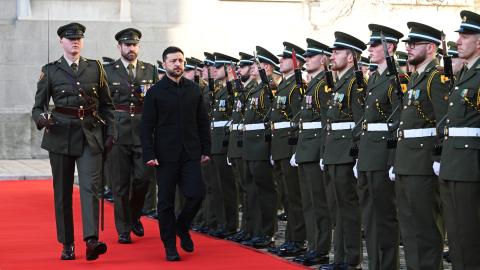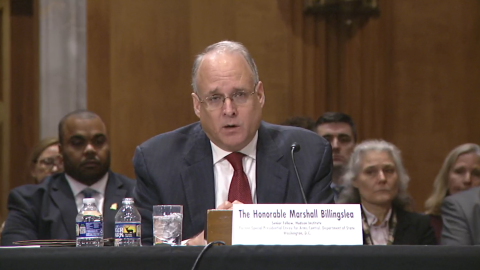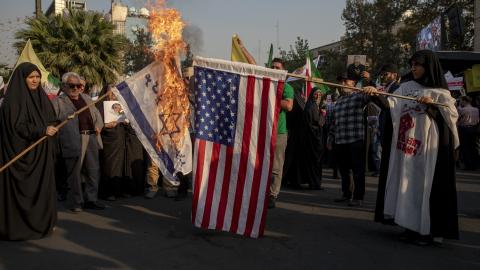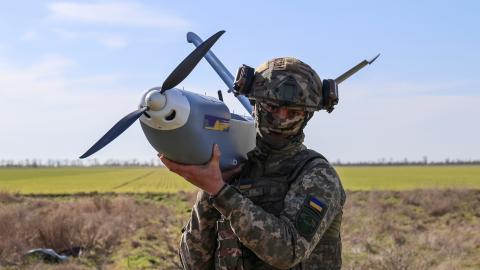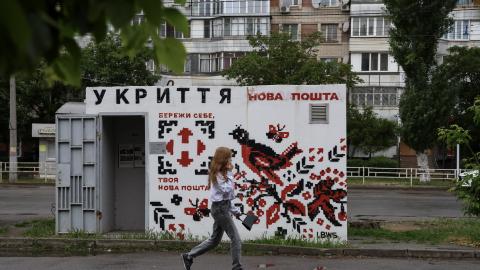In November 2022, Ukrainian forces liberated the right bank of the Dnipro River in Kherson Oblast after eight months of Russian occupation. These frontline troops found infrastructural devastation and a humanitarian catastrophe, and Ukrainian authorities had to act quickly to support the influx of internally displaced persons returning to the area. The governing body Ukraine put in place, the Kherson Regional Military Administration, has since done an extraordinary job at restoring public services and a semblance of normal life in a still-active combat zone.
This paper identifies some of the key lessons the military administration learned. The author collected information through regular interactions and interviews with officials from the Kherson Regional Military Administration. Under the leadership of Oleksandr Prokudin, this body shared its research and provided data and documentation. A delegation from Hudson Institute visited Kherson for an on-the-ground fact-finding mission in March 2025.
Local officials and policymakers in regions bordering Russia and Belarus should begin planning to ensure that, if crisis or armed conflict breaks out, essential services continue to function. This paper aims to serve as a guide for these officials.
Map 1: Ukraine's Kherson Oblast
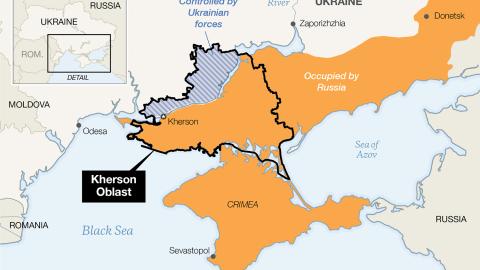
Source: CNN. Note: Locations are approximate.
The Kherson Region
Kherson Oblast, located in southern Ukraine (see map 1), is one of the country’s 27 administrative subdivisions. Its strategic location along the Dnipro River and the Black Sea has made it a coveted region for thousands of years. In antiquity, the region was inhabited by civilizations such as the Greeks and Scythians. Today, Kherson is an important agricultural region of Ukraine. The Port of Kherson also played a significant role in Ukraine’s prewar economy, serving as a major export hub—especially for agricultural products destined for the Global South.1
Kherson Oblast is roughly the same size as Massachusetts and, before the war, had a population of around one million people. As of mid-2025, approximately 30 percent of Kherson Oblast has been liberated and is under the control of Ukrainian authorities, while the remaining 70 percent remains under Russian military occupation. The Ukrainian-controlled section maintains a population of around 140,000 people, with about 65,000 living in the capital city, Kherson—both figures are significantly lower than prewar levels.2
Russia’s initial offensive in February 2022 advanced rapidly from the occupied Crimean Peninsula toward Odesa, first through Kherson and then into neighboring Mykolaiv Oblast. By March 1, Russia had captured the city of Kherson. The oblast remained under Russian occupation until Ukrainian forces liberated parts of it during their southern counteroffensive launched in late August—including the capital, which Ukraine liberated on November 11, 2022. Since then, the oblast has been divided: Russian forces control the southern portion (the left bank of the Dnipro River) while Ukrainian forces maintain control over the northern part (the right bank), including the city of Kherson.
It is not known how many Ukrainian citizens still live in the Russian-occupied left bank. Ukrainians on the right bank have minimal contact with those on the left, and civilians cannot move between the two sides. In addition, Russian authorities have carried out a broad crackdown on religious freedom and public use of the Ukrainian language in the occupied sections of the oblast.3 Kherson is also among the many regions from which Russian forces have abducted an unknown number of Ukrainian children and relocated them deep inside Russia—many at such a young age that they may never know they were born Ukrainian.4
In late summer 2022, Russian occupation authorities held a sham referendum in Kherson Oblast—alongside similar votes in Zaporizhzhia, Luhansk, and Donetsk Oblasts—that asked inhabitants whether they wanted to join the Russian Federation. According to the Russian-installed electoral commission, 87.05 percent of respondents in Kherson voted in favor.5 Ukraine and the international community immediately dismissed these results as fraudulent.6 Still, by October 4, the Russian State Duma and Federation Council had passed legislation to formally annex the four occupied regions into the Russian Federation.
Liberation and Establishment of the Military Administration
In March 2022, not long after Russian forces captured Kherson, the Ukrainian government established the Kherson Regional Military Administration. It was designed to ensure cooperation between civil and military elements, maintain continuity of governance, and develop plans to protect civilians. While almost all of Kherson Oblast was under Russian occupation, the administration operated from neighboring Kryvyi Rih. But since the liberation of the right bank and the city of Kherson in November 2022, the Kherson Regional Military Administration’s mandate and scope have expanded. It now serves as the local government in the area and regularly engages with the national government in Kyiv—specifically the Office of the President and key ministries including the Ministry of National Unity and the Ministry of Communities and Territories.7
When Ukrainian forces reentered the oblast after eight months of occupation, they encountered widespread destruction. Public services had all but ceased, and departing Russian troops had sabotaged the electrical grid, public water systems, transportation infrastructure, and other critical components of civilian life.8
The area that was liberated had undergone extreme devastation. According to figures from the Kherson Regional Military Administration, over 34,500 private houses and apartment buildings, more than 260 educational institutions, roughly 170 health care facilities, and nearly 20 bridges were destroyed in the fighting. Approximately 8,700 miles of road were also significantly damaged, severely affecting mobility and access to supplies.9
Ukrainian authorities had to act swiftly to restore public services—a formidable challenge given the shortage of trained personnel, equipment, and spare parts. Russian shelling and drone attacks from across the river remained a constant threat. But this did not deter the Ukrainians. Within 10 days, and under continuous bombardment, a major 150 kilovolt transmission line—stretching nearly 37 miles—reconnected Kherson Oblast to Ukraine’s national power grid. Just 15 days after Kherson’s liberation, power was restored to the city’s first substation. Within a month, 90 percent of the city of Kherson and approximately one-quarter of settlements across the oblast had power.10
Officials estimate that Russia carries out dozens of drone strikes each day, often targeting civilians in what is called a “human safari.” Reportedly, Russia sends newly trained drone operators to the region to gain practical experience before they deploy to other parts of the front. In 2024 alone, there were 40,700 recorded incidents of Russian forces shelling Ukrainian-controlled areas of Kherson Oblast. In these strikes, Russia expended approximately 218,000 shells.
The geography of the front line adds complexity to daily life. The main road bridge over the Dnipro River, the Antonivskyi Bridge, collapsed in November 2022. Both sides often use the ruins as a staging point to launch drones, some controlled with fiber-optic cables, across the river. The single-track Antonivka Railway Bridge was also destroyed in November 2022. With both bridges gone, cross-river transportation and logistics remain severely limited.
Ukraine’s only foothold across the river is a small bridgehead on the left bank that remains under constant attack. Meanwhile, Russian forces have tried repeatedly—but so far unsuccessfully—to establish their own foothold on the right bank.
The situation devolved further in June 2023, when Russian forces destroyed the Kakhovka Dam upstream on the Dnipro River. The dam’s destruction initially caused massive flooding in the city of Kherson and surrounding areas. When the waters receded, the Dnipro—once several miles wide in places—narrowed to just 200–300 yards in some stretches, drastically altering the tactical dynamics.
In many parts of Kherson, life has moved underground. A burned-out and half-destroyed building may conceal a staircase that leads to a modern, functioning hospital beneath. Above ground, local officials work tirelessly to maintain basic public services, ensure that public transportation and train connections (where operational) run on schedule, and encourage foreign investors to consider opportunities in the region despite the war.
Lessons from Kherson
The lessons from Kherson could be critical for officials in other regions in Eastern Europe, particularly those within the North Atlantic Treaty Organization. In a war with Russia, it is likely that Russia will occupy at least some NATO territory. When that territory is liberated, local officials may face challenges strikingly similar to what Kherson’s authorities experienced. Kherson can serve as a useful blueprint.
In the immediate aftermath of liberation, the Kherson Regional Military Administration faced a multitude of challenges but had limited resources to address them. As one of the first major regions to be liberated by Ukrainian forces, Kherson drew significant international attention and scrutiny. At the same time, the competition for resources was intense. The national government had prioritized rebuilding areas outside Kyiv, and the upcoming liberation of the Kharkiv region would soon further strain Ukraine’s resources. Meanwhile, as previously noted, Russian forces had left behind extensive destruction of civilian infrastructure. Adding to the complexity, thousands of Ukrainians who had been expelled from the Kherson region were eager to return, placing additional pressure on the already strained local systems responsible for restoring basic public services.
Ukrainian authorities quickly identified six high-priority services they would need to restore immediately following liberation:
- Electricity. Upon liberation, it became clear that the power system was in critical condition. All major substations were offline, and occupying Russian forces had either looted, damaged, or destroyed electrical infrastructure during their retreat.
- Water supply. The city of Kherson and the surrounding communities lacked functioning centralized water service. Pumping stations were damaged or without power, and many pipelines were leaking. Russian forces had also intentionally destroyed much of this infrastructure.
- Gas supply. Ukrainian forces discovered that Russian troops had dismantled many gas pipelines for scrap metal. Furthermore, Ukrainian officials had shut off gas flow in many areas due to safety concerns during combat operations. This left large populations without gas for cooking or heating as winter approached.
- Cellular communication and internet access. Russian forces had damaged or stolen much of Kherson’s communications infrastructure. The lack of electricity compounded the disruption.
- Transport infrastructure. Russian forces had destroyed many small bridges across the oblast during their retreat. Main roads were damaged and blocked with debris, including burned-out military and civilian vehicles. Additionally, Russian forces had heavily mined many areas. Public transportation was nonfunctional, and all train connections to other regions had been severed.
- Social infrastructure. Officials needed to work to reopen schools, hospitals, and local government offices. Many such buildings were destroyed in the fighting. Russian forces had also used some as barracks or storage areas, which they often looted or severely damaged while retreating. Valuable medical equipment had been stolen from hospitals, and widespread displacement caused staffing shortages, particularly among specialists.
It is worth noting that these six areas ensure just the most basic needs of the population. In addition, the Kherson Regional Military Administration had to work tirelessly on dozens of smaller issues. These included the restoration of the agriculture sector, creation of shelters in key areas to protect civilians from constant air attacks, documentation and preservation of historical archives, and reestablishment of law enforcement—all under combat conditions.
When interviewing local officials in Kherson and reviewing their internal lessons-learned documents, some key themes emerged. These may serve as a starting point for local and regional government administrators in frontline NATO countries.
The first is that officials need to properly triage the situation upon liberation. It is important that officials establish immediate infrastructural priorities based on their urgency. For example, the Kherson Regional Military Administration restored power to hospitals, water and heating facilities, and communication hubs before residential buildings. The administration prioritized getting each citizen the minimum amount of water required for survival, and then ensured critical facilities such as hospitals received a basic amount. Officials then focused on repairing main pipelines and powering pumping stations. The final phase of water restoration included returning to a regularly scheduled water supply and restoring sewage treatment facilities. When restoring public services, Kherson authorities found they should follow the mantra critical infrastructure first, residential consumers second.11 Not everything can be done at once.
Second, officials in newly liberated areas should not underestimate the challenge of demining and explosive ordnance disposal (EOD). These activities are a vital precursor to the restoration of public services and a return to normal life. At the local and regional government level, authorities can train civilians and utility workers to identify and mark unexploded ordnance and minefields for disposal by EOD professionals. Authorities will also need to coordinate with national-level defense and military officials, as well as international organizations specializing in ordinance removal. EOD operations are especially critical when reestablishing transport links and restoring natural gas pipelines in recently liberated areas.
Third, underground shelters are key for safety and continuity of life. The Kherson Regional Military Administration has invested heavily in building underground structures suitable for hospitals and education. In addition, day-to-day regional government operations occur mostly underground. But these structures were extremely costly and required major engineering and logistical feats. Officials in frontline regions should pre-construct or have plans in place for emergency construction of underground shelters.
Policy Recommendations for Frontline Local and Regional Governments
A Kherson official told the author, “We too once heard promises from the Kremlin dictator that Russia will never attack. Then, on the morning of February 24, 2022, we awoke to the sound of explosions.”12 Policymakers should not rule out further Russian aggression toward NATO’s eastern flank.
These recommendations are not exhaustive but provide a foundation for resilience planning that could help frontline NATO regions endure and recover from hostile occupation or sustained conflict. They are derived from Kherson officials’ experiences and should be useful for local and regional authorities.
- Develop continuity-of-government plans and legal frameworks for wartime authority. Ensure that local administrations have clearly defined protocols for emergency governance, including off-site backup locations, cloud-based information management, encrypted communication channels, and the ability to operate underground or in dispersed networks. Governments should also establish legal mechanisms that allow regional or municipal leaders to act decisively during armed conflict without waiting for national-level decrees.
- Conduct a comprehensive civilian capabilities assessment. Frontline national governments should evaluate current readiness by assessing available training, equipment, machinery, and spare parts on the regional administrative level. The goal is to identify gaps and develop a prioritized roadmap to strengthen resilience in case of partial Russian occupation.
- Establish a NATO-certified center of excellence on wartime local governance. NATO should work with Ukraine to identify wartime governance best practices, then establish a center of excellence to organize training exercises and support regional and local governments in crises. As an example, the regional government in Kherson is already sharing its experience with officials in NATO countries, including Sweden, Lithuania, and Latvia. This center should focus on these and other NATO states bordering Russia and Belarus.
- Embed civilian observers with the Kherson Regional Military Administration. Each frontline state—and possibly key European Union institutions—should consider sending non-combatant civilians to the Kherson Regional Military Administration to gain firsthand experience working in a military-civil environment. In addition, these same countries should invite experts from Kherson to meet with their respective local governments to learn how local military administrations operate under wartime conditions. NATO or the EU could help formalize these relationships through city-pairing initiatives between Kherson Oblast municipalities and those in NATO states.
- Count local wartime preparedness toward NATO defense-adjacent spending. NATO recently established an alliance-wide defense spending target of 5 percent of national gross domestic product. This guideline should count investments in local and regional wartime governance—such as training public workers, maintaining critical infrastructure, and ensuring continuity of essential services—toward the 1.5 percent of GDP that can go to defense-adjacent activities.
- Create a skeleton ministry of de-occupation and reintegration. Each frontline NATO state should establish a minimal but functional framework for a government ministry dedicated to de-occupation and reintegration. This skeleton ministry should develop operating procedures, staffing plans, and interagency coordination mechanisms to enable rapid activation in the event of a conflict with Russia.
- Map and prepare underground infrastructure in peacetime. Frontline NATO states should create a registry of existing underground facilities (such as basements, tunnels, and parking garages) and develop them for civilian and emergency government use. If required, governments should invest in the construction of new underground structures to better prepare the civilian population.
- Stockpile combat personal protective equipment (PPE). Governments should ensure their frontline regions have sufficient supplies of combat PPE, including body armor, helmets, and first aid kits. Teachers, police officers, utility workers, and other public servants may be exposed to combat-like risks. In any wartime emergency, national PPE stockpiles will be strained. So local and regional governments should prepare their own reserves now to ensure continuity of service and civilian protection.
- Pre-position key spare parts. Frontline states should stockpile essential spare parts to restore critical infrastructure—such as transmitters, electrical lines, pipelines, and other equipment associated with power stations, pump stations, and natural gas terminals. These governments should also conduct a thorough needs assessment and ensure stockpiles are far enough from expected lines of contact so supplies are secure and readily deployable upon the liberation of any occupied territory.
- Train local public workers for crisis scenarios. NATO and frontline member states should develop and implement training programs to help local government officials operate in active combat or semi-permissive environments. While most local government employees do not anticipate working under wartime conditions, the Kherson Regional Military Administration has shown that preparedness is key and to plan for the unexpected. Basic training could include first aid, mine/ordinance detection and clearance awareness, and even rehearsals for certain vital tasks. For example, public sector utility workers could practice repairing substations or pump stations while wearing personal protective equipment such as body armor and helmets.
The Kherson Regional Military Administration has learned these lessons the hard way. And although Ukraine has thus far resisted Russia’s invasion, Eastern European officials cannot rule out that Moscow’s aggression will expand in the future. To take full advantage of Ukraine’s bravery and resilience, other frontline states should begin to prepare for occupation now.




